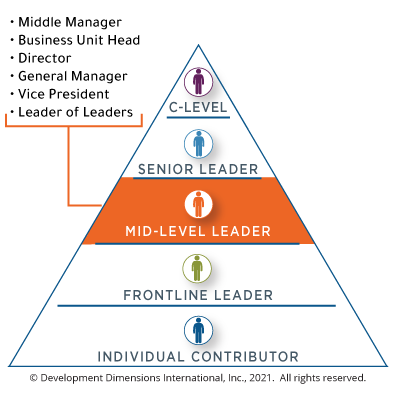Middle child. Middle school. Middleman. The word “middle” doesn’t usually conjure up good feelings as a description of people or places. For example, a Google search for “middle child” immediately returns results on “middle child syndrome,” the idea that middle children feel neglected and need extra attention to help them “shine.” Middle managers in the workplace also often get a bad rap. They too are often neglected, lack support, and are “caught in the middle.”
After all, middle managers are in a challenging role. They have to appease both their bosses, C-suite leaders, and the frontline managers they lead. They’re the go-between when it comes to executing top-down strategy. But they also must ensure that frontline leaders are motivated and have what they need to get their jobs done. Talk about exhausting.
Recent headlines confirm that middle managers are getting burned out. And to top it off, the very value of middle managers is in question. When layoffs loom, middle managers are often the first to be sacked.
But companies would be remiss to remove middle management from their org charts. Without middle managers, organizations put themselves at major risk for lacking the leadership necessary to drive strategy to change, which is essential for business survival today.
In this blog, I’ll define who mid-level managers are and the overwhelming value effective middle managers bring to an organization. Plus, given their unique position to connect strategy to results, I’ll answer: how can we best develop and set up middle managers for success?
Who Are Middle Managers?

Middle managers are the business unit heads, directors, general managers, vice presidents, and other job titles that exist between frontline managers and executive leadership teams. They are leaders of leaders but are not members of the C-suite. They manage people who manage others.
The scope of a middle manager’s role is often broad. Some middle managers are responsible for training and developing their teams and performance management, while other companies may delegate these responsibilities to other departments.
Depending on the organization, a middle manager may have a varying number of direct reports. This was especially true after the pandemic, when many organizations flattened to speed up strategic change. Additionally, the lines between what middle managers and senior leaders are responsible for have become blurred.
Middle managers are the linchpin for connecting strategy and execution. They are the glue that holds everything together and commonly the buffer between executive direction and frontline action. Beyond just these practical deliverables, middle managers are also the ones who make the biggest impact on the organization's culture—often considered the make or break to inclusivity.
So today, what are middle managers really responsible for and what unique value do they bring to organizations?
Here are four key ways middle managers create value for companies.
4 Ways Middle Managers Bring Unique Value to Organizations
Based on DDI’s research, data from assessments, and experience working with organizations worldwide, here are four areas where middle managers make the most impact.

1. Accelerate Change at the Speed of Life
Middle managers can be a catalyst to accelerate change and transformation. We know businesses are changing faster than ever. So if you don’t have strong mid-level leadership, then you likely don’t have the glue to hold the organization together as it drives forward or tries something new.
Companies need mid-level leaders that can drive change quickly while managing complexities. For example, think about the novel challenges brought on by the hybrid workplace or changes to data and privacy laws.
Mid-level leaders experience unique pressure to interface with executives on business strategy, then translate that into words and actions that make sense to the rest of the organization. They also support their peers and teams to keep everyone moving toward the organization’s goals.

2. Empower Multiple Teams
The second area where middle managers make the most impact is navigating multidirectional expectations. This includes working across teams and often breaking down silos. Mid-level managers need to engage and empower their teams, which may require different tactics depending on the different disciplines that report to them.
For example, I work with one finance director of a European retail organization. He refers to having six formal teams, which include finance controllers and managers in five countries, plus someone to manage the finance systems. But he talks about another six informal teams he needs to influence and engage: legal, fashion, design, sales, marketing, and production. It would be impossible for him to achieve his own goals in accounting without working closely alongside all of these teams. So he must not only coach his six team members, but about 20 other managers to keep everyone aligned and on track.
This example is not uncommon. Because so many organizations are matrixed today, middle managers have a huge opportunity to empower teams beyond their own. Leaders with strong influencing skills can have a tremendous impact on their organization.

3. Navigate Visibility and Vulnerability
Years ago, we used to think that the spotlight only followed top executives. If the company didn’t hit business targets, executive jobs might be on the line. Middle managers now share this pressure.
Greater visibility into the performance of mid-level leaders has created a new sense of vulnerability—and it’s burning them out. According to a recent survey by Slack Technologies Inc.’s Future Forum, middle managers are the most exhausted of all organizational levels.
I recently spoke with a group of middle managers and one of them said, “What happens if the company decides my function isn’t performing? I’m gone.”
As middle managers’ output has become more visible, their to-do lists and challenges often remain invisible. Another middle manager told me, “The board doesn’t often see all that I do—so I could appear deadweight to them.”
Middle managers who can successfully navigate increased visibility and feelings of vulnerability are in a better position to help their organizations succeed. For example, middle managers who can do this well are more likely to take calculated risks to spur innovation and are better able to make quick decisions, which also benefits innovation. Mid-level leaders who can manage vulnerability are not derailing their teams and instead are modeling great leadership behaviors—including leading authentically. Authentic leaders manage vulnerability and build greater trust with their teams.

4. Lead a Complex Network
Today there is heightened pressure on mid-level leaders to cultivate and maintain a productive network across their organization. Leading complex networks is a skill that is crucial to keeping the organization humming along and problem solving quickly.
For example, to solve a problem, you need to understand what others are going through. You also need to be able to go to the person who can help you the fastest.
I recently worked with a head of global sales who told me that when she stepped into her role, she reached out to other middle managers in the organization for advice. Going forward, she purposefully connected with other leaders every couple of months.
This relationship-building paid off when her biggest client had a massive data privacy challenge. Because she had a connection with the head of data security, she could quickly ask for help. Within an hour, the top techs at the firm were offering support to the client. Without the relationship with the data lead at her organization, she doesn’t think they would have moved as fast to help her client.
It is easy to miss opportunities to build networks. Yet, we’ve seen the most effective middle managers make time to build these important networks to drive progress.
How to Help Middle Managers Succeed
We know effective middle managers can make a huge impact on their organizations by:
- Successfully driving change and transformation
- Empowering multiple teams
- Navigating visibility and vulnerability
- Leading a complex network
But how can you ensure your middle managers are skilled in these areas?
The bad news is that your middle managers are more than likely not effective. According to DDI’s Global Leadership Forecast 2023 research, only 26% of HR rated their mid-level leader quality as very good or excellent.
Perhaps it’s no surprise then that only 27% of HR leaders rated the quality of their mid-level leadership development programs as high or very high.
It’s smart for organizations to offer development programs crafted specifically for middle managers. An effective middle manager program is highly personalized to give mid-level leaders the skills they need to overcome the specific challenges they face.
Rebranding Middle Managers
At the recent Association for Talent Development (ATD) conference, as I was speaking with my peers, I proposed co-creating a name for middle managers that would better reflect their important role.
The session participants voted to rebrand middle managers as strategic connectors, a much more fitting description of the challenging and valuable role these unsung heroes play in organizations today. While middle managers are still unsung heroes, at least we are taking positive steps to start recognizing their impact.

Learn more about how to develop strategic connectors in our webinar, Unsung Heroes: High-Impact Development for Middle Managers.
Verity Creedy is Vice President of DDI’s Product Management team and an award-winning blogger. Verity is obsessed with building powerful development experiences for leaders, trying to hold a decent plank for two minutes, and keeping indoor plants alive for more than six months.
Topics covered in this blog

